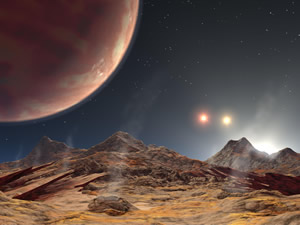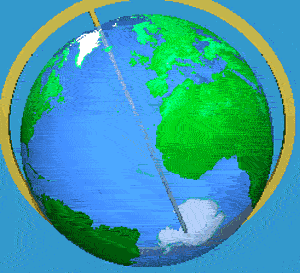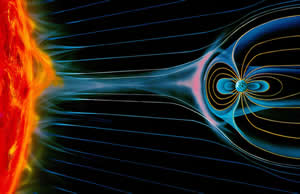
The first consideration is that of gravity. What is more desirable a planet with exactly the same gravitational force as our own Earth or one with a higher or lower gravitational force. A planet's gravity will determine a number of other important parameters.
The gravity of an object is described by the equation g=GM/r2 where G is the constant for gravitation, M is the planet's mass and r is its radius. that is, gravity is proportionall to an object's mass divided by its radius squared.
It really is a balancing act; too much gravity will crush any possible life, and too little gravity will make it difficult for the planet to retain a protecting atmosphere.
Some of the effects of a low gravity planet are:
-
less effort required for lifting or moving about;
-
thinner air, as lower gravity can hold less air against a planet, resulting in a lesser endurance.
-
weaker muscles, joints and bones. Low gravity causes bones to be depleted of calcium and become porous a condition known as osteoporosis.
-
reduction in the strength of the heart as it has to work less to pump blood against a lower gravity than on Earth.
Some of the effects of a high gravity planet are
-
more effort needed to move about on the surface;
-
stronger muscles and joints to cope with the increased gravitational pull;
-
increased strength required for each contraction of the heart, which may prove harmful to people with weak hearts.
-
blood vessel damage as blood pools in the legs and may cause varicose veins.

However a planet with a dense atmosphere and greater gravitational force may not prove to have the effects listed above. As the atmosphere becomes denser, under a greater gravitational force, the buoyant force would compensate and provide support, much like water supports the great mass of a whale. If a whale was to become stranded on land it would collapse under its own weight.
Different life forms may evolve to take advantage of the denser air. Life forms that can float through air like many sea creatures float through the water here on Earth.

The rotational speed of the planet is somewhat critical to the ecosystems that may be found on a particular planet. For example, consider a rotational speed that has a day that is hundreds of times longer than on Earth. Differences in temperature would be so extreme that life forms would find it hard to survive. What about the ecosystems that need sunlight as a source of energy? The length of night would make it hard for photosynthesis to occur and provide a source of energy for life.
However not all life forms must be Earth-like. Life forms may evolve that can store energy for great lengths of time or, may be, go into a type of suspended animation in the long winter as happens here on Earth.
A shorter period of rotation would result in a better temperature distribution around the planet..

A 23.5 degree tilt of the Earth on its axis gives us the seasons. Since the Earth's orbit is, somewhat, circular around the Sun seasons are created due to the tilt of the Earth. If there were no tilt, there would be little or no seasonal variation. The only way to create seasons without such an axial tilt is to alter the orbit of the planet, making it extremely eccentric as opposed to the almost circular orbit of the Earth

Do we wish our new planet to have a moon as does the Earth? What are the implications of having an orbiting neighbour. If one moon is great will many moons be better?
The moon is the source of tides on Earth. Many moons will undoubtedly create complex tidal forces. When a multiple moon system reaches a certain alignment tidal forces can create catastrophic and chaotic events.

How important is it for the planet, that we are to colonise, to have a magnetic field? If so, how strong should it be? Our planet has a magnetic field, which has allowed life to develop. It protects the Earth from the devastating effects of solar winds and cosmic rays.
The solar wind mentioned above is a stream of charged particles that blow outward from the Sun's surface at about 400 km/second. The Earth's magnetic field shields it from much of the solar wind. When the solar wind encounters Earth's magnetic field, being composed of charged particles, it is deflected around the Earth as illustrated in the image on the right. Solar winds are a source of deadly radiation so a magnetic field around the planet to be colonised is critical since our planet would have to be close to an energy source such as a star similar to our own Sun.

Sourcefrom https://www.youtube.com/watch?v=QDqskltCixA
The source of our magnetic field is thought to be created by the currents of molten rock flowing deep in the Earth's core. A cross-section of the Earth shows a layered appearance with an inner solid core and an outer liquid core and it is this liquid core that is thought to be responsible for the Earth's magnetic field. Around the core is the mantle, a layer about 2900 kilometres thick, which is the dominant layer of our planet. Over the mantle is the lithosphere (crust), which is the outermost shell of the Earth.
The lithosphere is made up of several solid pieces called plates. These plates are in constant motion.
This plate tectonic activity, as shown on the left, is responsible for the formation of mountain ranges, as happens when two plates collide with one another, the creation of oceanic trenches, and earthquakes. Earthquakes arise when plates crash into each other or slide past one another.
View the video on the left of the early earth.
What is the source of the heat energy deep beneath the surface of the earth?
Earth's atmosphere is made up of 78% nitrogen, 21% oxygen and small percentages of several other gases. Ideally it would be good if the planet we are colonising has this mixture.
Air pressure also influences the temperature at which liquids boil. Our blood would begin to form bubbles if the planet had a very low air pressure. This situation is recognised here on Earth as the bends and affects deep seas diver who surface too quickly. Earths atmosphere offers some protection from the radiation emitted by our local, nuclear energy source, the Sun.
Gases such as ozone absorb U.V. radiation while the rest of our atmosphere absorbs other harmful radiation. Carbon dioxide in the atmosphere traps heat by absorbing the Sun's infrared radiation and warms the our Earth. Without carbon dioxide in the atmosphere our Earth would be too cold.
If a planet has an atmosphere then its speed of rotation is important in determining wind speeds.
Having a high rotation planet can whip winds to hurricane speeds. However, having a slowly rotating planet will also result in high wind speed, because warmed air from the hot side will move to the cooler side. So it is important to get it just right otherwise expensive engineering would have to be undertaken to build dwellings that can withstand high speed winds.
Another way to alter wind speed is to alter the composition of the atmosphere. A different percentage of certain compounds in the planetary atmosphere will influence the density of the atmosphere, which would alter the wind dynamics of the planet.
The difficulty of choosing a planet for colonisation emphasises how unique Earth is in the Universe.
Gravitational attraction of the planet is critical. State whether the comments below are true or false.